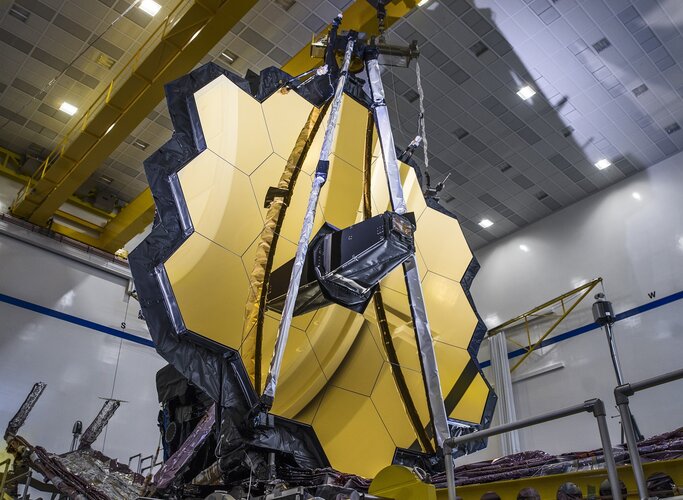
Copernical Team
NASA Mirrors on ESA Pathfinder to Empower Space Geodesy
 NASA will supply the upcoming European Space Agency (ESA) Lunar Pathfinder mission with an array of laser retroreflectors, mirrored devices that reflect light back at its source. The retroreflectors will offer new opportunities for lunar science and space geodesy.
Geodesy is the scientific discipline that seeks to map Earth's shape, orientation, and gravity field. Space geodesy uses satell
NASA will supply the upcoming European Space Agency (ESA) Lunar Pathfinder mission with an array of laser retroreflectors, mirrored devices that reflect light back at its source. The retroreflectors will offer new opportunities for lunar science and space geodesy.
Geodesy is the scientific discipline that seeks to map Earth's shape, orientation, and gravity field. Space geodesy uses satell Searching for Sand Transport
 Perseverance is currently stopped for sampling at Skinner Ridge rock. Sampling activities constitute an important aspect of Perseverance's mission, and the rover's strategic path is developed around sampling stops. During these stops, the rover must remain stationary for at least twelve sols in order to conduct proximity science and activities related to abrasion and coring. But being parked in
Perseverance is currently stopped for sampling at Skinner Ridge rock. Sampling activities constitute an important aspect of Perseverance's mission, and the rover's strategic path is developed around sampling stops. During these stops, the rover must remain stationary for at least twelve sols in order to conduct proximity science and activities related to abrasion and coring. But being parked in Surprise - Again! Asteroid Bennu Reveals its Surface is Like a Plastic Ball Pit
 After analyzing data gathered when NASA's OSIRIS-REx spacecraft collected a sample from asteroid Bennu in October 2020, scientists have learned something astonishing: The spacecraft would have sunk into Bennu had it not fired its thrusters to back away immediately after it grabbed dust and rock from the asteroid's surface.
It turns out that the particles making up Bennu's exterior are so l
After analyzing data gathered when NASA's OSIRIS-REx spacecraft collected a sample from asteroid Bennu in October 2020, scientists have learned something astonishing: The spacecraft would have sunk into Bennu had it not fired its thrusters to back away immediately after it grabbed dust and rock from the asteroid's surface.
It turns out that the particles making up Bennu's exterior are so l Porosity of the moon's crust reveals bombardment history
 Around 4.4 billion years ago, the early solar system resembled a game of space rock dodgeball, as massive asteroids and comets, and, later, smaller rocks and galactic debris pummeled the moon and other infant terrestrial bodies. This period ended around 3.8 billion years ago. On the moon, this tumultuous time left behind a heavily cratered face, and a cracked and porous crust.
Now MIT scie
Around 4.4 billion years ago, the early solar system resembled a game of space rock dodgeball, as massive asteroids and comets, and, later, smaller rocks and galactic debris pummeled the moon and other infant terrestrial bodies. This period ended around 3.8 billion years ago. On the moon, this tumultuous time left behind a heavily cratered face, and a cracked and porous crust.
Now MIT scie NASA mirrors on ESA pathfinder to enhance lunar navigation

NASA will supply the upcoming European Space Agency (ESA) Lunar Pathfinder satellite with an array of laser retroreflectors, mirrored devices that reflect light back at its source. The retroreflectors will validate navigation capabilities that will be critical to the Artemis missions and future lunar exploration.
Three of the four instruments on NASA's Webb telescope ready for science

Cosmic targets for Webb Telescope’s first images announced

The NASA/ESA/CSA James Webb Space Telescope will soon reveal unprecedented and detailed views of the Universe, with the upcoming release of its first full-colour images and spectroscopic data.
Discs for fault detection
 Image:
Discs for fault detection
Image:
Discs for fault detection Week in images: 04-08 July 2022

Week in images: 04-08 July 2022
Discover our week through the lens
Using lasers and 'tow-trucks', Japanese firms target space debris

From laser beams and wooden satellites to galactic tow-truck services, start-ups in Japan are trying to imagine ways to deal with a growing environmental problem: space debris.
Junk like used satellites, parts of rockets and wreckage from collisions has been piling up since the space age began, with the problem accelerating in recent decades.
"We're entering an era when many satellites will be launched one after another. Space will become more and more crowded," said Miki Ito, general manager at Astroscale, a company dedicated to "space sustainability".
"There are simulations suggesting space won't be usable if we go on like this," she told AFP. "So we must improve the celestial environment before it's too late."
The European Space Agency (ESA) estimates that around one million pieces of debris larger than a centimeter—big enough to "disable a spacecraft"—are in Earth's orbit.
